We’ve been makin’ tracks like a posse’s on our backside and I’ve been told we’re well ahead of time on the trail. So let’s dip down into the Black Hills since we’re right here and all, and visit a couple monuments worth takin’ a gander at. Don’t y’all worry we’re just leavin’ Wyoming for today, we’ll be back on the straight and narrow in no time.
Last time we gawked at a monument created by nature, and Devils Tower was a goodun! Today we’re gonna swing by a monument man carved out of the mountain…Mount Rushmore (sorry no hidden treasure folks, I don’t care what Nicholas Cage says). Wagons Ho, folks! We’re burnin’ daylight.
Doane Robinson, the aging superintendent of the South Dakota State Historical Society, had a vision of a massive mountain memorial carved from stone and so large it would put South Dakota on the map and increase tourism. In 1923, Robinson started telling everyone of his dream of giant statues of Western figures including, Chief Red Cloud, Buffalo Bill Cody, Lewis and Clark and legendary Sioux warriors marching along South Dakota’s skyline. [On a personal note as awesome as Mount Rushmore is, Robinson’s original idea of a monument to Western personalities sounds amazing]
Robinson began campaigning for his mountain statues, speaking to local organizations 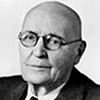 and writing letter upon letter to government organizations. Many South Dakotans believed Robinson’s massive sculptures would attract thousands of tourists and their wallets. Others found the notion ludicrous. When newspaper stories stopped and snickers ceased, Robinson enlisted the aid of the respected U.S. Senator Peter Norbeck.
and writing letter upon letter to government organizations. Many South Dakotans believed Robinson’s massive sculptures would attract thousands of tourists and their wallets. Others found the notion ludicrous. When newspaper stories stopped and snickers ceased, Robinson enlisted the aid of the respected U.S. Senator Peter Norbeck.
Norbeck, a frequent visitor at the White House, held the admiration of his peers in the Senate, as well as, the farmers and ranchers of South Dakota who sent him to Washington. He was instantly captivated by Robinson’s mountain-carving proposal and encouraged Robinson to seek a sculptor capable of commanding such a project.
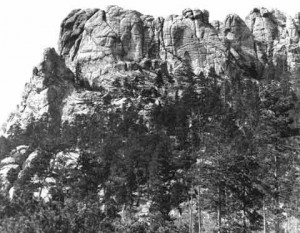 In August of 1924, Robinson contacted Gutzon Borglum who was working at Stone Mountain, Georgia on Robert E. Lee. Robinson invited Borglum to visit South Dakota and talk over the possibility of carving a mountain. Borglum took Robinson up on his offer and met with him in September of 1924 and again in August of 1925. During his second trip Borglum found Mount Rushmore. Next, Borglum and his party climbed Harney Peak. At 7,242 feet, this is the highest point between the Rockies and the Swiss Alps. The surrounding vista inspired him.
In August of 1924, Robinson contacted Gutzon Borglum who was working at Stone Mountain, Georgia on Robert E. Lee. Robinson invited Borglum to visit South Dakota and talk over the possibility of carving a mountain. Borglum took Robinson up on his offer and met with him in September of 1924 and again in August of 1925. During his second trip Borglum found Mount Rushmore. Next, Borglum and his party climbed Harney Peak. At 7,242 feet, this is the highest point between the Rockies and the Swiss Alps. The surrounding vista inspired him.
“Here is the place!” Borglum exhorted. “American history shall march along that skyline.”
He set his sights on the craggy, pine-clad cliff known as Mount Rushmore, near the isolated mining town of Keystone. It had southeastern exposure, giving it direct sunlight most of the day, and was made of sound granite relatively free from fracture. Borglum carefully explored the crevices and samples the rock of Mount Rushmore reconfirming with each test that he found his mountain.
SIDETRAIL: Mount Rushmore is named after New York City attorney Charles E. Rushmore, who came to the Black Hills in 1884 to check legal titles on properties. On returning to Pine Camp he asked Bill Challis the name of this mountain. Bill replied, “Never had a name, but from now on we’ll call it Rushmore. “ Never hurts to ask, folks ya might get a mountain named after you. Okay back on the main trail.
However, Borglum informed Robinson and Norbeck his life’s work would not be spent immortalizing regional heroes. The sculptor insisted the work demanded a subject “national in nature and timeless in its relevance to history.” So then who…
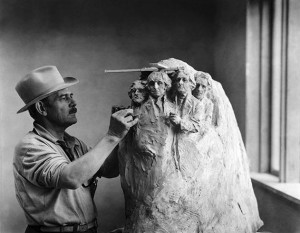 George Washington: First President. Led the early colonists in the American Revolution. Father of the new country and laid the foundation of American democracy. Because of his importance, Washington is the most prominent figure on the mountain.
George Washington: First President. Led the early colonists in the American Revolution. Father of the new country and laid the foundation of American democracy. Because of his importance, Washington is the most prominent figure on the mountain.
Thomas Jefferson: Third President. He was the author of the Declaration of Independence, as document which inspires democracies around the world. He also purchased the Louisiana Territory from France in 1803, which doubled the size of our country, adding all or part of fifteen present-day states.
Theodore Roosevelt: Twenty-sixth President. He provided leadership when America experienced rapid economic growth as it entered the 20th Century. He was instrumental in negotiating the construction of the Panama Canal, linking the east and the west. He was known as the “trust buster” for his work to end large corporate monopolies and ensure the rights of the common working man.
Abraham Lincoln: Sixteenth President. Held the nation together during its greatest trial, the Civil War. Lincoln believed his most sacred duty was the preservation of the Union. It was his firm conviction that slavery must be abolished.
Robinson now had his sculptor, but the challenges to his dream had just begun. Now 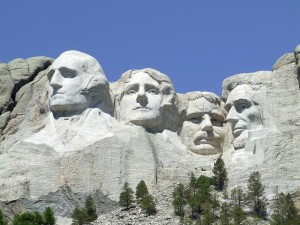 permission was needed to carve into the mountain. Senator Norbeck and Congressman William Wiliamson (a man equally inspired by Robinson’s vision) were instrumental in getting legislation passed to allow the carving. Williamson drafted two bills, one for Congress and one for the State Legislature. The bill requesting permission to use Federal land for the monument easily passed. The bill sent to the State of South Dakota was not going to pass so easily. The Mount Harney National Memorial bill was defeated twice and almost a third time, when on March 5, 1925, Governor Gunderson signed the bill. The Mount Harney Memorial Association was established later that same summer.
permission was needed to carve into the mountain. Senator Norbeck and Congressman William Wiliamson (a man equally inspired by Robinson’s vision) were instrumental in getting legislation passed to allow the carving. Williamson drafted two bills, one for Congress and one for the State Legislature. The bill requesting permission to use Federal land for the monument easily passed. The bill sent to the State of South Dakota was not going to pass so easily. The Mount Harney National Memorial bill was defeated twice and almost a third time, when on March 5, 1925, Governor Gunderson signed the bill. The Mount Harney Memorial Association was established later that same summer.
More than the legislation involved was finding money to fund the project, despite Borglum’s promise of large donations from wealthy eastern businessmen. Borglum also promised the people of South Dakota they would not be responsible for paying for any of the mountain carving.
With Congressman Williamson’s assistance, President Calvin Coolidge agreed to visit the Black Hills in 1927. Borglum planned a formal dedication of the mountain. Borglum hired a plane to fly over the State Game Lodge in Custer State Park where Coolidge was staying. As he flew by Borglum dropped a wreath inviting the President to attend the dedication ceremony. Coolidge agreed, and on August 10, 1927, Mount Rushmore was formally dedicated. President Coolidge gave a speech promising federal funding for the project.
Borglum met with Secretary of the Treasury, Andrew Mellon and convinced the Secretary of the projects importance. Mellon offered to fund the entire project, but Borglum said he would only need half the money from the government, the rest he could raise privately. Senator Norbeck was stunned than Borglum turned down full funding (Hint from Kirsten: NEVER turn down full funding)
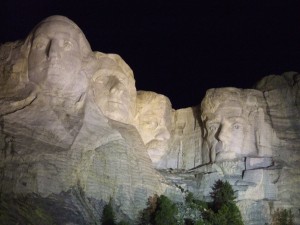 President Coolidge signed the bill authorizing federal funding matching funds up to $250,000.00 and created the Mount Rushmore National Memorial Commission. The Commission would consist of 12 members appointed by the President. Coolidge appointed ten and said Hoover should appoint the other two.
President Coolidge signed the bill authorizing federal funding matching funds up to $250,000.00 and created the Mount Rushmore National Memorial Commission. The Commission would consist of 12 members appointed by the President. Coolidge appointed ten and said Hoover should appoint the other two.
Hoover quickly appointed the final two members, when he took office, but he never met with the Commission. The Commission had to meet with the president to begin work. Congressman Williamson was asked to make an appointment with the President. Despite interference from Borglum that almost ruined everything, Williamson eventually met with the President and convinced him of the importance of the project. Hoover met with the Commission within a couple days. Officers were elected and the day following the meeting Williamson and Boland (the secretary of the executive committee) went to Mellon and received the first funding.
One notable, and sad, exclusion from the new Commission was Doane Robinson. The father of the project was not even put on the list of potential candidates to serve on the committee to be selected by the President. Robinson continued to support the project and generously offered, “Let me help where I can.” Soon, feeling unnecessary, Robinson moved away from the Rushmore project altogether.
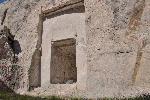 Now with the Commission organized and money in the bank, workers were hired and carving began. After only a few years under the National Park Service, in 1938, Borglum removed all road blocks to his complete control of the Rushmore project. The Commission was reorganized granting Borglum control. Again, Borglum’s ambition threatened the project, when he proposed a Hall of Records, a large repository carved into the side of the canyon behind the carving of the Presidents, to the story of Mount Rushmore and America. Work was stopped in 1939 because the threat of losing all funding if the money was not used on carving the faces as was intended. Work on the Hall of Records ceased and was never started again.
Now with the Commission organized and money in the bank, workers were hired and carving began. After only a few years under the National Park Service, in 1938, Borglum removed all road blocks to his complete control of the Rushmore project. The Commission was reorganized granting Borglum control. Again, Borglum’s ambition threatened the project, when he proposed a Hall of Records, a large repository carved into the side of the canyon behind the carving of the Presidents, to the story of Mount Rushmore and America. Work was stopped in 1939 because the threat of losing all funding if the money was not used on carving the faces as was intended. Work on the Hall of Records ceased and was never started again.
Carving the monument was a project of colossal proportion, but would end in colossal achievement. It involved the efforts of nearly 400 men and women. Duties ranged from call boy to drillers to blacksmiths and housekeepers.
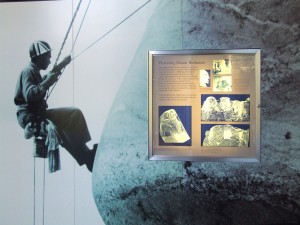 Workers endured conditions that varied from blazing hot to bitter cold and windy. Each day they climbed 700 stairs to the top of the mountain to punch-in on the time clock. Then 3/8 inch thick steel cables lowered them over the front of the 500 foot face of the mountain in a bosun chair. Some of the workers admitted to a fear of heights, but during the Great Depression any job was a good job.
Workers endured conditions that varied from blazing hot to bitter cold and windy. Each day they climbed 700 stairs to the top of the mountain to punch-in on the time clock. Then 3/8 inch thick steel cables lowered them over the front of the 500 foot face of the mountain in a bosun chair. Some of the workers admitted to a fear of heights, but during the Great Depression any job was a good job.
The work was exciting, but dangerous, 90% of the mountain was carved using dynamite. The powderman would cut and set charges of dynamite of specific sizes to remove precise amounts of rock. Before the dynamite charges could be set off, the workers were cleared from the mountain. Workers in the winch house on the top of the mountain would hand crank the winches to raise and lower the drillers. If they went too fast, the drillers in their bosun chairs would be dragged up on their faces. To keep this from happening young men and boys were hired as call boys. Call boys sat at the edge of the mountain and shout messages back and forth assuring safety. During the 14 years of construction not one fatality occurred.
Dynamite was used until three to six inches of rock was left to remove to get to final carving surface. At this point, drillers and assistant carvers would drill holes into the granite very close together. This was called honeycombing. The closely drilled holes would weaken the granite so it could be removed often by hand.
A great story about honeycombing comes from the workers.
Visitors would become very interested in the honeycomb granite and would ask, “How can I get a piece of rock like that?”
The hoist operator would respond, “Oh, I can’t give that away. I’m holding onto it for a buddy of mine that works up on the mountain.”
The visitor would respond, ” I’ll pay, I’ll give you $2.00 for it.”
The hoist operator’s reply was, “Nope, nope, I’d really catch if I gave away my buddies piece of granite.”
Well the visitors were very determined to get a piece of that granite. They would make another offer. “I’ll give you $6.00 for that piece of honeycomb granite.
Well, the hoist operator would pretend to pause and think about it… then he would say, “Alright for $6.00 I’m willing to take the heat.”
The hoist operator would give the visitors the piece of Honeycomb granite and take their $6.00. The visitor would leave very pleased with their rare and hard won souvenir. The hoist operator would wait until he was sure the visitors were gone, then he would get on the phone going to the top of the mountain and he would say, “Boys send down another one!” Another piece of honeycomb granite was sent down, ready for the next visitor looking for a special souvenir from Mount Rushmore.
After the honeycombing, workers smoothed the surface of the faces with a hand facer or bumper tool. The bumper tool would even up the granite, creating a surface as smooth as sidewalk.
From 1927-1941 the 400 workers at Mount Rushmore earned $8.00 a day building a monument people from around the world would visit for generations.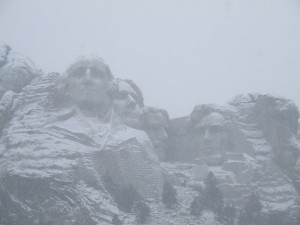
For the final two years of the project, Lincoln, Borglum’s son (who had been literally following in his father’s tracks during the entire project) took over while Gutzon constantly tried to get more money for the project. In March of 1941, as the final dedication was being planned, Gutzon Borglum died. With the artist gone and a World War on the horizon work on Mount Rushmore drew to a close. October 31, 1941 the monument was declared complete.
Between receiving permission, finding funding, dueling personalities at times it was harder to keep the project on track than to do the colossal carving of the four Presidents. However, in the end cooler heads, charm and determination saw the project through to the end, and created an American icon in the Black Hills.
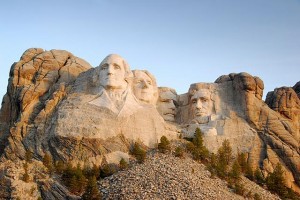 And while yer trekking through the Black Hills stop on over and see the Crazy Horse Monument. Still being carved from the mountain this one should be a real beaut!
And while yer trekking through the Black Hills stop on over and see the Crazy Horse Monument. Still being carved from the mountain this one should be a real beaut!
Equipped with only a sledge hammer, a single-jack drill bit and a box of dynamite, Boston-born sculptor Korczak Ziolkowski went to work on June 3, 1948 creating his 563 by 641-foot sculpture of an Indian man atop a spirited warhorse. This would later be called Crazy Horse Memorial. He would spend the next 36 years of his life doggedly blasting away 7,400,000 tons of granite near Custer, South Dakota to rough out virtually the entire figure, in the round.
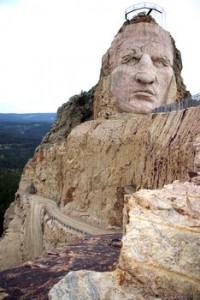 Now years after Korczak started carving and his death in 1982, work continues on the world’s largest sculpture. The dimensions are awe inspiring. The mountain-sized statue is as long as a cruise ship and taller than a 60-story skyscraper!
Now years after Korczak started carving and his death in 1982, work continues on the world’s largest sculpture. The dimensions are awe inspiring. The mountain-sized statue is as long as a cruise ship and taller than a 60-story skyscraper!
When Korczak died, critics reckoned the mountain outlasted the man. But Korczak’s wife Ruth and their ten sons and daughters were determined to keep his vision alive using the plan books and scale models he left behind.
Together, the wife and children brought forth a heroic face from the granite of the Black Hills during the decade of the 90s. The 88-foot-high face of Crazy Horse was dedicated on June 3, 1998, 50 years to the day after Korczak’s first blast.
Work now focuses on the 219-foot-high horse’s head. Blocking out the 22-story high figure has surpassed the halfway mark. There’s a lot of excitement about witnessing Crazy Horse’s steed take shape as these cliff-hanging explosive experts work their fleet of drilling equipment. A new generation of visitors watches as a new generation of workers carry the Crazy Horse dream forward.
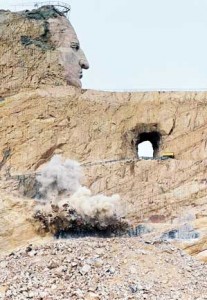 If ya haven’t seen Mount Rushmore, and takin’ a gander at what they’re accomplishing with the Crazy Horse Memorial, well than brother and sister load up the wagon and get ya there! I mean NOW doggonit! Don’t just sit there starin’ at the dang computer screen get out and see it for yerself!
If ya haven’t seen Mount Rushmore, and takin’ a gander at what they’re accomplishing with the Crazy Horse Memorial, well than brother and sister load up the wagon and get ya there! I mean NOW doggonit! Don’t just sit there starin’ at the dang computer screen get out and see it for yerself!
Now I’ve gotta go drag Cookie away from the dang helicopter ride. “Cookie! Ya old coot, no one needs ta see yer carcus hoverin’ over the Presidents in that there whirly-bird! Get on back to the wagon!”
SOURCES:
http://www.nps.gov/moru/historyculture/mount-rushmore-national-memorial.htm
http://www.ohranger.com/mount-rushmore/making-mount-rushmore
http://www.blackhillsbadlands.com/home/thingstodo/parksmonuments/crazyhorse




